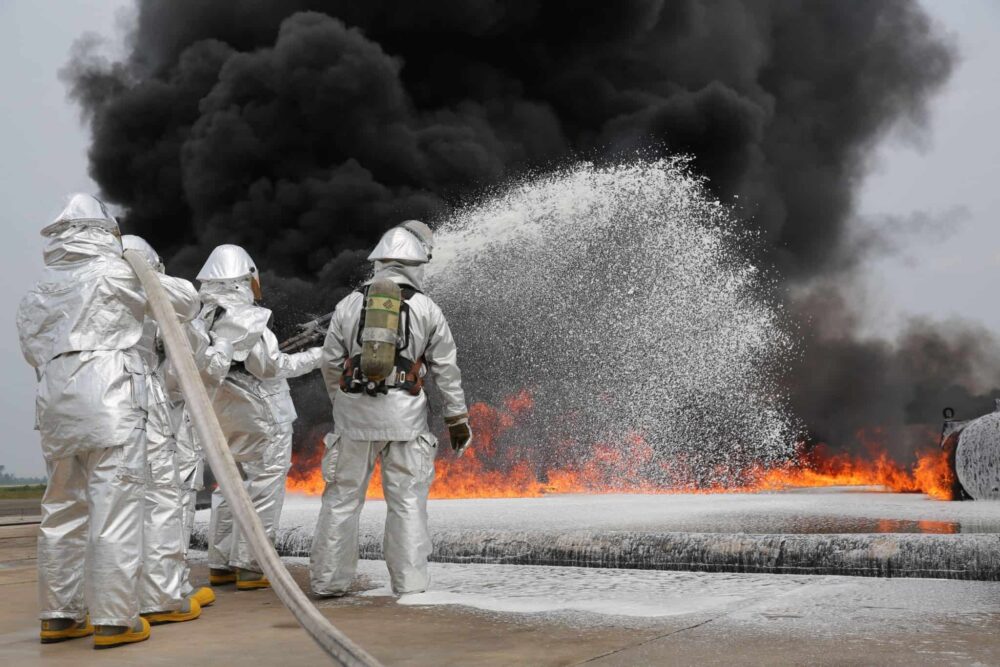Aqueous film-forming foam (AFFF), a firefighting essential, is now entangled in legal complexities due to per- and polyfluoroalkyl substances (PFAS). As lawsuits against major manufacturers like 3M surge, unraveling the legal nuances surrounding AFFF and PFAS exposure is critical.
In this article, we will explore the multidimensional health implications, regulatory actions, and the evolving AFFF litigation.
Understanding the Chemical Culprits
Beyond the notorious PFAS components PFOS and PFOA, AFFF harbors a complex mix of chemical elements. Phased production of PFAS since the 1950s hasn’t fully eradicated their presence in AFFF formulations.
This lingering persistence raises environmental and health concerns, as the legal landscape grapples with managing the ongoing ramifications of historical PFAS use.
Understanding the intricate chemistry of these substances is crucial for navigating their legal implications. Moreover, the evolution of AFFF formulations over the years adds another layer of complexity.
Manufacturers have introduced modifications to reduce the environmental impact of firefighting foams. While these modifications aim for a more sustainable approach, they also pose legal challenges in determining the effectiveness of these changes.
The Impact of AFFF Exposure

Source: vbattorneys.com
TruLaw notes that while the immediate firefighting benefits of AFFF are undeniable, long-term exposure poses significant health risks. Recent legal claims dive into the extensive research connecting AFFF exposure, especially with PFOS and PFOA, to a broader spectrum of health issues.
According to the Maryland Reporter, kidney cancer and prostate cancer are two of the most common illnesses associated with it. It can also cause fertility problems and thyroid. The legal narrative gains depth as scientific findings reinforce the gravity of the health implications linked to PFAS exposure. Proving causation becomes crucial in shaping legal arguments.
The legal discourse surrounding AFFF lawsuits is beginning to acknowledge the potential risks posed during critical stages of life. This has prompted a reevaluation of safety standards and regulations. The intricate interplay between PFAS and the immune system is gaining legal attention, with claims pointing towards long-term consequences on antibody production and immunity.
EPA’s Role in PFAS Management
The EPA’s introduction of the Significant New Use Rule (SNUR) in 2021 marked a significant step in regulating PFAS. According to the Federal Register, people are required to notify EPA at least 90 days before commencing the manufacture of goods under SNUR. However, enforcing these regulations presents challenges.
The legal discourse now grapples with the effectiveness of these measures, exploring the potential areas for strengthening regulatory frameworks to address the PFAS issue. Stakeholders closely watch for legislative updates that may shape future legal strategies.
In parallel, the legal discourse is grappling with the question of corporate responsibility in PFAS management. As the EPA enforces the SNUR, companies manufacturing or using PFAS-containing products like AFFF are under heightened scrutiny. Legal challenges may arise as entities contest alleged violations, adding layers of complexity to the evolving legal landscape.
AFFF Lawsuits and Manufacturer Accountability

Source: drugwatch.com
As more people are filing the AFFF lawsuit, major manufacturers like 3M are facing intense legal investigations. According to Reuters, DuPont and Kidde-Fenwal are two other companies that have been dragged into the case. The litigation has cost Kidde-Fenwal $6 million this year alone.
The legal battleground pivots around proving not just the presence of PFAS but also establishing the manufacturer’s knowledge of associated health risks. As the litigation evolves, the nuanced discussion around manufacturer accountability adds layers of complexity to the legal narrative. Emerging evidence may reshape the legal landscape, influencing the trajectory of ongoing cases.
Despite the legal complexities, the ongoing litigation signifies a broader societal push for accountability and awareness surrounding the potential hazards of firefighting tools. The outcome of these lawsuits has the potential to impact the lives of individuals who have suffered health consequences while also influencing industry practices.
Military and Environmental Implications
The involvement of military facilities as major users of AFFF introduces a unique dimension to the legal discourse. Beyond individual lawsuits against manufacturers, legal actions are extending to scrutinize military facilities contributing to groundwater contamination.
Communities surrounding these facilities are exploring legal avenues, broadening the scope of accountability in the legal framework. Environmental impact assessments play a crucial role in determining liability.
Moreover, military personnel, both current and former, are emerging as key figures in AFFF-related lawsuits. Firefighters on military bases, often using AFFF extensively during training exercises and emergency responses, face heightened risks of health complications due to prolonged exposure.
This has prompted legal actions not only against manufacturers but also against military authorities for potentially inadequate protective measures.
Settlement Attempts and Challenges
Manufacturers, recognizing the magnitude of legal challenges, attempt to resolve the disputes through substantial settlements. While 3M’s $10 billion offer is a notable attempt, plaintiffs face the intricate task of evaluating the benefits against potential legal complexities and uncertainties.
As plaintiffs weigh the pros and cons of settlement options, the legal landscape remains fluid. New scientific evidence, regulatory developments, and the outcomes of other AFFF lawsuits can significantly impact the calculus for both parties. The dynamics of AFFF litigation settlements underscore the complexity of resolving mass torts involving diverse health issues.
This legal tug-of-war over settlements unfolds as a critical chapter in the broader AFFF litigation narrative. Negotiations may set precedents for future settlement dynamics in similar cases.
Future Trends and Considerations

Source: northcarolinahealthnews.org
As AFFF and PFAS-related litigation progresses, projecting future trends becomes crucial. The legal landscape may evolve with emerging legislative actions, scientific advancements, and the trajectory of ongoing cases.
Stakeholders must navigate these dynamic elements to understand how the legal dimensions surrounding AFFF and PFAS exposure will shape up in the coming years. Collaboration between the legal and scientific sectors is critical for accurate forecasting of future trends.
In summary, the evolving legal landscape surrounding AFFF and PFAS exposure involves health risks, regulatory challenges, and manufacturer accountability. Military and environmental implications further complicate the discourse, while settlement attempts reflect the delicate balance between resolution and complexity.
Ultimately, stakeholders must anticipate trends shaped by legislation, science, and ongoing cases, emphasizing collaboration for a comprehensive understanding of future developments.












